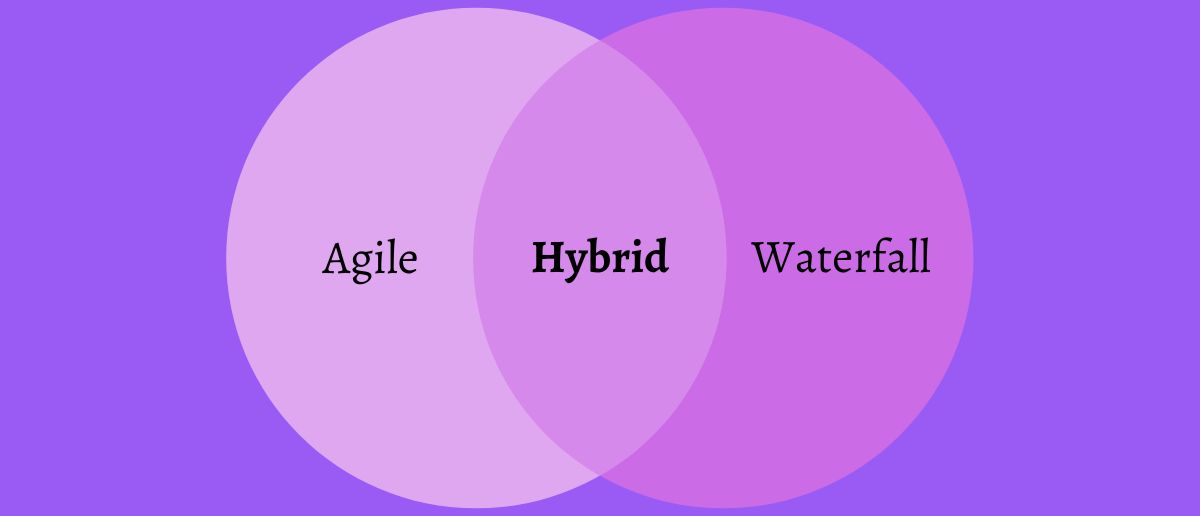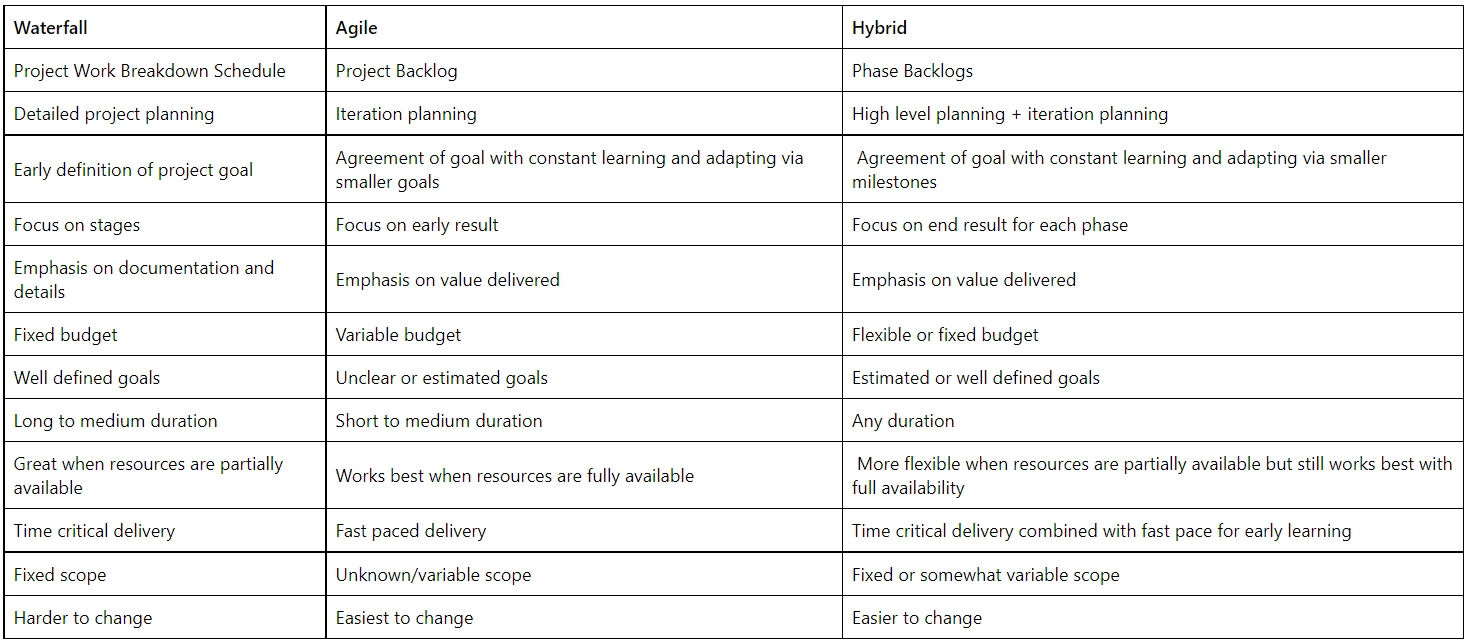
August 9 2023
4 min read

Apr
How often have you seen companies investing in project management tools only to have them fade to black after stops and starts? This happens because managers fail to find the best project management approaches that fit the team’s requirements.
There’s one common dilemma organizations are stuck with:
Should we use Agile or Waterfall project management?
What if your project needs the best of both?
PMI found that 60% of companies well versed in Agile prefer a blended approach to project management.
Welcome to hybrid project management, the perfect cocktail of Agile and Waterfall. If you are familiar with the concept, let’s have a quick refresher.
Hybrid project management combines the best traits of Agile and Waterfall techniques to fit dynamic project requirements.
It is adaptive (Agile) yet retains the firm characteristics of Waterfall per your project needs. It integrates the planning strategies from traditional project management (Waterfall) with the fast and flexible Agile approach.
It is also called blended project management.
And the result?
A perfect blend of predictive and uncertain work based on:
Collecting and documenting requirements
Design
Coding
Unit testing, system testing, and user acceptance testing
Bug fixing
Delivering end product
Best yet, it opens up room for creativity. You can use new and unique strategies to manage projects better.
Before we hop on to the benefits of hybrid project management, let’s first understand the challenges that gave rise to this technique.
Shortest answer: the demerits of Agile and Waterfall. The constant tussle between the tight constraints of Waterfall and resistance to the fast-paced nature of Agile was impacting project results. That’s when the inception of the hybrid/blended project management tool took place.
As a wise middle ground, it has the potential to address the following challenges:
Project complexity: Changing dynamics in nearly all industries make projects more complex. This calls for improved project management strategies that yield the best results from start to completion.
Market competition: With new technologies ruling the market, businesses compete to stay relevant and proactively respond to emergent issues.
Customer expectations: Fast-evolving customer expectations are spurring companies to focus on personalization, speed, ease, and usability.

Hybrid project management empowers you to combine the best of Agile and Waterfall and develop a custom approach. This helps your team deliver top-notch outcomes. Here’s how.
A direct transition from Waterfall to Agile is riddled with challenges for many companies. The teams find it complicated to shift to a fast-paced environment with frequent, incremental updates.
Hybrid project management acts as a bridge. It helps your team members cope with the new ways of working and reduces leaps and bounds. The blended approach facilitates the transition by applying specific indicators to processes that need to be faster and more flexible.
The leap to Agile does not happen overnight. It’s not easy, either. Not all organizations and projects are structured to adapt rapidly. Serious roadblocks may arise if your project’s space and time are narrow enough.
If you need to expedite your project but can’t compromise on quality and other factors, the hybrid approach is the best route for a smooth transition.
So you figure that the sudden shift to Agile is taking a toll on your team, deliverables, timelines, etc. What do you do now? Revert to Waterfall?
It’s too late. The hybrid route is your best bet. This way, while you dodge the risks of Waterfall, you can gradually adapt to the elements of Agile.
As a project manager, you must determine the quickest and hassle-free path to achieving your project goals. Hybrid or blended project management enables you to complete your project within budget and on time while maintaining certain specifications.
Hybrid project management lets you tailor your strategies based on the project requirements. As a project manager, you can collect continuous feedback and make incremental changes while distinctly identifying the phases (as per the Waterfall approach).
The Agile half of this hybrid technique makes room for adaptability and flexibility while quickening the pace of the project. In complex and dynamic environments, team members should be able to assess the project and make changes without disrupting the progress. The hybrid technique makes your projects customizable.
No wonder it is becoming the go-to project management strategy for organizations.
The waterfall half of hybrid project management ensures the project is well-planned and carefully executed. Project managers need to map out all the end-to-end processes. This provides a clear roadmap for your team members in terms of the following:
Project requirements
Individual roles and responsibilities
Expectations
Deadlines
If you are using hybrid project management to transition to Agile, your teams may often wonder how Agile is flexible. The hybrid route is the best way for them to learn and adapt. Before switching to Agile, they can implement plans meticulously while understanding the long-term project goals.
In blended project management, clients and developers agree on the deliverables in the early development lifecycle stage. This lets managers split projects up into smaller segments known as sprints. This allows clients and team members to view real-time progress and updates.
The team can work on updates and changes along the way through iterations.
Evidently, hybrid project management enhances your team’s morale. Blended project management yields maximum efficiency when you communicate well with stakeholders and teams and reach a mutual understanding.
The perfect combination of careful planning and emergence helps your project team deliver innovative outcomes.

Blended project management is not a one-size-fits-all solution. You need to understand Waterfall completely and Agile techniques to know how to combine them for the best results.
Projects new to the hybrid approach face a few common challenges:
Communication gaps
Since most teams are used to the Waterfall approach, it takes them a while to switch to Agile completely. When they use blended project management during the transitioning phase, constant and clear communication is necessary.
Project managers must have an explicit process to loop every member during feedback, and the reports should be documented.
Your team also needs to understand the expectations of the clients clearly and stakeholders. The hybrid approach works best when they have clear insights into the end goals and their roles in achieving them.
Resistance to change
A common struggle for teams implementing hybrid project management is: not being on the same page. A few team members may struggle to upgrade to the new methods.
The best way to level up as a team is to follow systematic planning while leaving room for updates and changes. Team members need to be trained on any new skill required to adapt to the changes.
Stakeholder management
The first roadblock could be your stakeholders and project sponsors. They may not be familiar with the hybrid style and could resist change.
Getting buy-in from your stakeholders gets easier when you provide them with additional support, such as constant status updates, project changes, and more.
Conflict resolution
Early on, project managers often find it challenging to track deliverables and check if the deadlines are being met. This may often lead to conflicts that require administrative intervention and result in a loss of time and resources.
Practical knowledge and flexibility
Real-time experience matters. When you combine two different project management techniques, you need practical knowledge of real-world challenges and how to address them.
Additionally, you must know the practices and principles to steer the project in the right direction.** **
Flexibility is the key. If your team members, partners, and stakeholders aren’t prepared for constant changes to the project, the hybrid way might not produce the best results. Flexibility as a unit lets you test new changes and deliver better outcomes.
IBM is known for implementing hybrid project management for teams transitioning to Agile. The IBM Center of Excellence in Illinois, Chicago, conducted a study to combine Agile with traditional development approaches.
They named this hybrid: Agile with Discipline.
The project managers tried to understand how the hybrid technique helps develop new methods to improve current programs and practices.
They interviewed the senior project managers, architects, and project leads to understand what influences their decisions to use hybrid project management. All the project managers were disappointed with traditional practices. With Hybrid Agile (an IBM terminology), they could make the best use of the following:
Detailed documentation
Flexible timelines
Adaptability to accommodate changes
Development sprints
Continuous feedback
Hybrid project management allowed these PMs to be hands-on managers actively engaged in leading people, arranging resources, and delivering quality outputs. On being asked how the project manager’s role changes in hybrid teams, a senior PM responded:
How the PM delivers his/her solution and involves customers is what changes. The PM still owns the project, still drives the project through the completion of sprints, still goes through all of the checks and balances needed, and still gets all of the required sign-offs. The things that change are that the PM has a lot more interaction with the customers, leads daily sprint calls with the team, and scopes the projects a bit differently (i.e. delivery in smaller chunks and frequent reviews with the customer).
- IBM Senior Project Manager
Let’s now discuss the case of Atypon, a California-based software company. Atypon implemented hybrid techniques to improve the existing workflow. They were developing a new website for a publishing company.
To complete the project within timelines, they were required to shift over 1000 journals to the new website. Now this was a monumental task.
The team started with the Waterfall approach but later switched to Agile. They thought it would help them manage the changing variables. Soon they realized they needed a hybrid middle ground.
Hybrid project management helped Atypon to:
Deliver end results via Waterfall
Address unforeseen challenges (variables) via Agile
Make the best use of limited resources and time
Brainstorm and share new ideas
The team delivered the software three months in advance. How often do you hear that?
Bringing together everything we discussed, hybrid project management boils down to a few basic steps:
1. Focus on the challenges you must address: Identify and list the issues you must resolve in your present development process. Collect inputs from your team members like:
What challenges are they facing?
What improvements do they suggest?
What goals and milestones did they set for themselves?
These discussions help you determine the degree of the challenges and the optimal ways to resolve them. If there are a lot of issues, you need to fix, prioritize and focus on the one that’s impacting your team the most. When your people see you actively engaging in the project and rectifying the issues, they become more invested in delivering the best outputs.
2. Ensure your team is on board with the process: You may have team members who’ve never worked in a hybrid environment. You need to ensure they are well-versed with Agile and Waterfall first. Start training them on the new processes before you start planning your tasks and deliverables.
3. Carefully select and implement hybrid elements: Once you have clarity of the issues, you must determine the Waterfall to Agile ratio to make the perfect hybrid cocktail.
The perfect blend won’t happen in a day.
Carefully examine all project parts to determine which processes are defined and which are flexible. Use Waterfall for the processes that are strictly defined. For processes that have room for change, Agile is the best fit.
4. Finalize your strategy: The strategy you select for a particular project must be well-defined. Altering your project strategy mid-way can confuse the team members and impact the project results.
The best approach is to track and assess the outcome so you can decide if the same strategy will work for your future projects.
The hybrid approach looks different for various teams and projects. You can blend your project management methods in one of three ways:
Combining Waterfall and Agile teams
Using Waterfall for a part of the project and Agile for the rest
Planning a steady hybrid approach with specific elements from both
As a project manager, you need to make every minute count. With a practical knowledge of all project management techniques, you will always have a competitive edge. Edbrick’s expert-designed training programs can help you stay a cut above. Connect with us today for a free consultation.

August 9 2023
4 min read

July 18 2023
6 min read

June 19 2023
8 min read

June 12 2023
5 min read